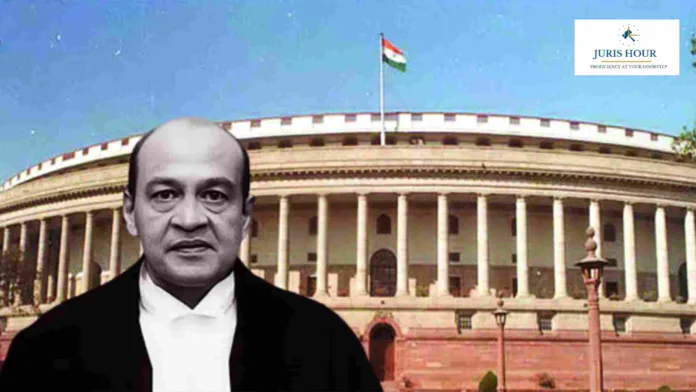The Union Government is reportedly seeking to introduce an impeachment motion to remove Justice Yashwant Varma of the Allahabad High Court, following the discovery of sacks of burnt currency at his Delhi residence earlier this year. Justice Varma, who earlier served at the Delhi High Court, is said to have been indicted by an in-house committee of the Supreme Court, constituted by then Chief Justice of India (CJI) Sanjiv Khanna. Despite a reported recommendation for resignation, Justice Varma has chosen to stay on, prompting the CJI to write to the President and Prime Minister seeking his removal.
However, the central government’s approach in this matter is raising serious constitutional and procedural questions. At the heart of the controversy is the apparent attempt to circumvent the statutory process mandated under the Judges (Inquiry) Act, 1968, which lays out a detailed framework for the removal of a judge on grounds of proven misbehaviour or incapacity.
Who Can Initiate Impeachment?
Under the 1968 Act, the initiation of a motion for the removal of a judge lies solely with Members of Parliament (MPs) — not with the executive. A motion must be signed by at least 100 MPs in the Lok Sabha or 50 MPs in the Rajya Sabha before being submitted to the respective presiding officer. The central government, as per the law, has no direct role in initiating this process.
Reports suggesting that the Union Government is building political consensus for the removal and considering bypassing the committee envisaged under the 1968 Act are constitutionally alarming. Not only does this create the impression of executive overreach, but it also threatens the independence of the judiciary and due process.
In-House Inquiry vs Statutory Committee: Key Distinctions
The government appears to be relying on the findings of an in-house inquiry initiated by the then CJI. However, such inquiries, as reiterated in judicial precedent, are internal, non-statutory mechanisms devised to uphold ethical standards within the higher judiciary. They are not substitutes for the formal process mandated under the Judges (Inquiry) Act.
Unlike the committee under the 1968 Act, which is empowered to summon witnesses, take evidence under oath, and offer the judge a chance to defend themselves through legal representation, the in-house inquiry has no such procedural or legal powers. It functions solely as a fact-finding body and cannot determine charges or recommend punitive action.
In Indira Jaising v. Registrar General, Supreme Court of India (2003), the Supreme Court made it clear that in-house procedures are based on moral authority and not enforceable legal standards.
MPs Denied Access to Report
Further complicating matters, the in-house report which reportedly formed the basis of the CJI’s recommendation to the executive has not been made available to Members of Parliament. Given that MPs are the only constitutionally empowered actors to initiate the impeachment process, denying them access to this crucial document raises fundamental questions about transparency and fairness.
Without this report, MPs are unable to make an informed decision on whether to sign and submit a motion for Justice Varma’s removal. This lack of access contradicts the principles of procedural fairness enshrined under Articles 14 and 21 of the Constitution.
Constitutional Provisions and Statutory Safeguards
The removal of a judge is governed by Article 124(4) of the Constitution, which requires an address by each House of Parliament, supported by a majority of the total membership and a two-thirds majority of those present and voting, in the same session. Article 124(5) enables Parliament to frame laws to regulate this process — resulting in the enactment of the Judges (Inquiry) Act, 1968.
Article 218 extends these provisions to High Court judges. Therefore, the removal process for Justice Varma must comply with this rigorous constitutional framework.
The 1968 Act stipulates that once a motion is admitted by the Speaker or Chairperson, a three-member committee must be formed to investigate the charges. This committee comprises:
- A Supreme Court judge or the Chief Justice,
- A Chief Justice of a High Court, and
- A distinguished jurist.
Only upon a finding of guilt by this committee can the motion proceed for debate and voting in Parliament. If the committee finds the judge not guilty, the motion lapses automatically.
Precedents Support Committee Formation
There are clear precedents supporting the constitution of a statutory inquiry committee despite prior in-house findings. In the case of Justice Soumitra Sen, such a committee was formed after an in-house probe and a recommendation by the CJI. A similar route was followed in the case of Justice S.K. Gangele of the Madhya Pradesh High Court.
In these cases, the in-house reports were not used as substitutes for the formal process. Rather, they served as the basis for MPs to initiate the motion, which then triggered the formation of the statutory committee under the 1968 Act.
Concerns Over Delay and Constitutional Evasion
Legal experts and observers argue that the current approach being considered by the Union Government risks creating a constitutional crisis. Any attempt to bypass or short-circuit the provisions of the Judges (Inquiry) Act could invite judicial intervention and delay the process — possibly derailing it altogether.
This scenario echoes the controversy surrounding Justice N. Narayan Shukla, whose in-house report was never made public and whose removal was stalled due to procedural ambiguities and executive inaction.
Need for Reform in In-House Procedure
The present controversy also underscores the need to revisit and reform the in-house mechanism. While it can serve as a preliminary ethical review, its findings should either be made available to MPs or automatically trigger the process under the Judges (Inquiry) Act.
Currently, there is an irony in the fact that while the executive is privy to the in-house report, Parliament — the only body constitutionally mandated to act upon it — is not.
Conclusion
The impeachment process for Justice Yashwant Varma has brought to the fore serious questions about judicial accountability, procedural integrity, and the separation of powers. While there is moral weight behind the in-house committee’s findings, they cannot displace the statutory and constitutional process laid out under the Judges (Inquiry) Act.
For the credibility of India’s judicial system and the sanctity of constitutional due process, it is imperative that the Speaker of the Lok Sabha and the Chairperson of the Rajya Sabha adhere strictly to the legal framework. Any deviation risks not only the derailment of the process but also the erosion of judicial independence — a cornerstone of Indian democracy.
Read More: Air India Crew Member and Kingpin Arrested for Smuggling Gold Worth ₹1.41 Crore from U.S. to Mumbai

